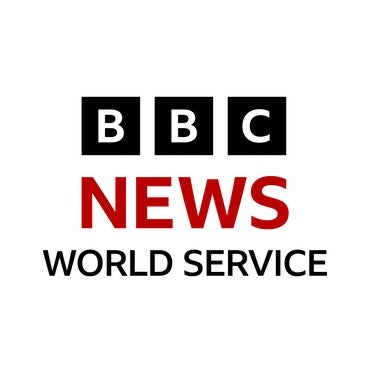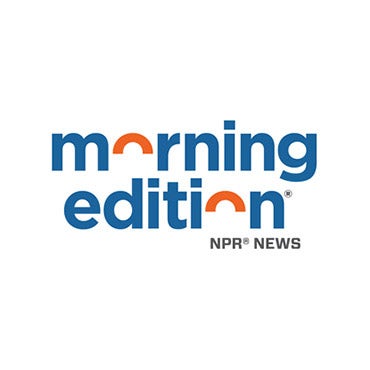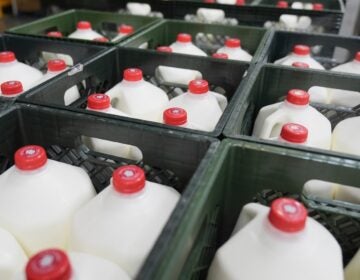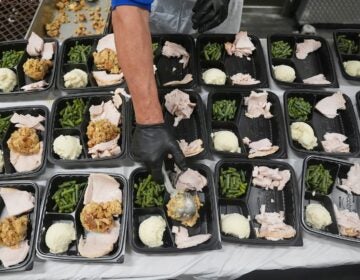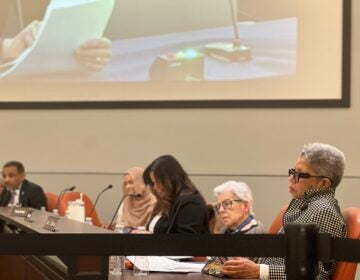1 in 3 Pa. SNAP recipients are kids. As cuts remain in limbo, Philly-area schools face ‘uncertainty’ feeding students
Nearly 241,000 children in Bucks, Chester, Delaware, Montgomery and Philadelphia counties receive SNAP benefits.
Listen 0:45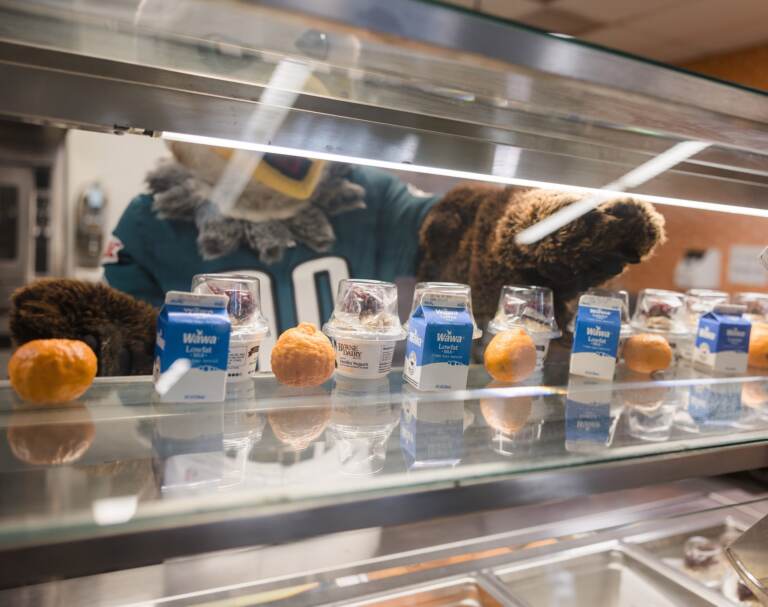
Items available at a Philly school cafeteria, with Eagles mascot Swoop in the background. (Courtesy School District of Philadelphia)
SNAP funding freeze: What to know
- 42 million people — about 1 in 8 Americans — rely on SNAP
- Locally, that includes nearly 2 million people in Pa., with roughly 685,000 in the Philadelphia region, and more than 800,000 in New Jersey
- Here’s how to find other free food resources in the Philly region and in South Jersey, and how to help
Nearly 42 million people in the U.S. count on the Supplemental Nutrition Assistance Program, commonly referred to as SNAP, for food. All are at risk of that support vanishing or, at the very least, being drastically reduced.
SNAP benefits were set to be frozen in November because of the federal government shutdown.
A lawsuit driven by 25 Democratically-led states rallied to force the federal government to partially fund the program. On Friday, a federal judge ruled in favor of the temporary effort.
But SNAP’s future remains in jeopardy. The judge, Indira Talwani, set a Monday deadline for the Trump administration to say if it will release at least reduced SNAP benefits in November. Asked before the ruling about whether the U.S. Department of Agriculture would commit to releasing the funds if ordered by a judge, Secretary Brooke Rollins did not commit to doing so, saying the department is “looking at all the options.”
Until Congress reaches a deal, states are gearing up for a possible freeze in the decades-old program.
More than 2 million people in Pennsylvania rely on SNAP to feed their families each month. About 1 in 3 SNAP recipients are under the age of 18, according to the Pennsylvania Department of Human Services.
Nearly 241,000 children in Bucks, Chester, Delaware, Montgomery and Philadelphia counties receive SNAP benefits, approximately 162,000 of whom live in qualified households in Philadelphia.
If SNAP’s freeze goes into effect, it would likely lead to more hungry kids. Here’s how local school districts are preparing to respond:
Philadelphia school district food programs remain operational
The School District of Philadelphia serves approximately 118,000 students across 250 district and alternative schools. Another 80,000 students attend the 81 charters operating in the city.
Students in the district currently receive free breakfast and lunch. The district runs a handful of lunch programs, some of which involve federal partners.
In a letter to the school community Friday, Deputy Superintendent of Academic Services Jermaine Dawson wrote that the district’s “commitment to the well-being of Philadelphia children and families remains steadfast.”
“Our mission is to ensure that no child goes hungry during the school day, and we’re committed to providing nutritious meals that fuel learning and academic success,” Dawson wrote.
The district’s various food programs remain operational.
“While we cannot send food home, we encourage all students to take advantage of the meals served in our cafeterias,” Dawson wrote. “Please help us spread the word to families and students about the importance of eating meals at school.”
Dawson also encouraged the use of “share tables” in the cafeterias to reduce waste and support those with extra food needs.
“At share tables, students can leave unopened, packaged items they don’t want, for others to take as needed,” he wrote. “It’s a simple way to foster community and reduce waste.”
‘Uncertainty’ hangs over Upper Darby’s free lunch program
Pennsylvania’s budget is four months late. The stalemate in Harrisburg has created a dual crisis for chronically underfunded school districts.
About 12,500 kids are enrolled in the Upper Darby School District in Delaware County.
In a video message to families, Superintendent Dan McGarry said Tuesday that the district is at a crossroads. It costs $25 million a month to operate its schools.
“If there is not a budget passed soon, we are going to have to go out and borrow money and pay interest on that money — in a school community that already cannot afford to have even more funding passed on to our local taxpayers,” McGarry said.
Upper Darby operates a free breakfast and lunch program for all enrolled students, regardless of economic background.
“There is uncertainty about how that program will continue to function in the near future without a federal budget,” McGarry said. “At this point in time, we have received information that we are OK through the month of October. We do not yet know what will happen as we move forward. But I want to let you know that we’re going to continue to do our best to make sure that we are providing breakfast and lunch to all of the students here in the Upper Darby School District.”
Wendy Elgart, the district’s director of federal programs, grants and food service, sent a notice to families Friday afternoon about its Community Eligibility Provision program, the free breakfast and lunch service, which is funded in partnership with the federal and state government.
“At this time, the state has no budget passed, and the funds that allow for that reimbursement are in question,” Elgart said. “The district is committed to doing everything in its power to continue to serve all of our students two meals a day. At this time, we have sufficient district food service funds to continue to feed our students breakfast and lunch through December, 2025.”
Norristown’s free breakfast and lunch continues — but meal distribution events will be ‘significantly hampered’
The Norristown Area School District in Montgomery County serves about 7,600 students in its 12 schools. The district’s food service department annually cooks more than 1 million breakfast and lunch meals, free of charge.
“Like you, NASD is frustrated by the impact it’s having, including disruptions to programs such as SNAP benefits and other essential supports,” Superintendent Christopher Dormer wrote Friday in a letter to families. “Please know that breakfast and lunch will continue to be available for all students at no cost.”
In a statement to WHYY News, the school district said more than 70% of students identify as “economically disadvantaged.” Although the district remains “grateful” it can continue its breakfast and lunch program, the challenges are not going away.
“With the state budget impasse withholding millions of dollars of funding from our district, our ability to provide additional aid and support will be significantly hampered, at a time when we know the interruption of SNAP payments will harm so many of our families,” the district wrote.
In previous years, the district organized meal distribution events before long breaks from school, holidays and over the summer to keep food options available for families.
“The current impasses will limit our ability to do more right now when need is most critical,” the district wrote. “We will continue to assess ways that we can deliver the distribution events our families have come to rely on as we approach our first set of extended breaks this upcoming holiday season.”

Get daily updates from WHYY News!
WHYY is your source for fact-based, in-depth journalism and information. As a nonprofit organization, we rely on financial support from readers like you. Please give today.
